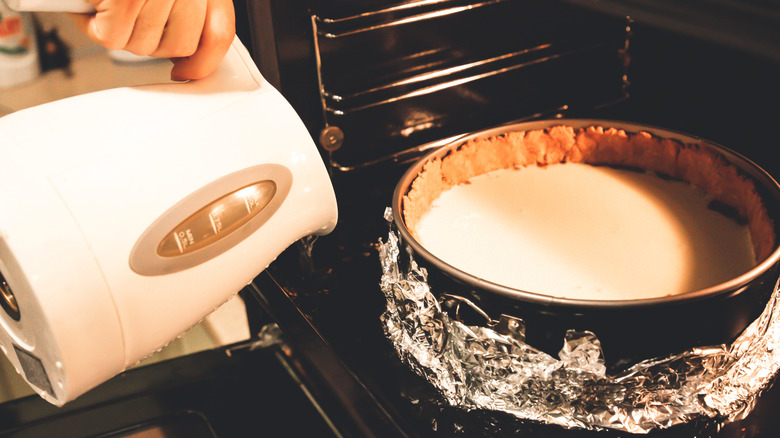Why Low And Slow Baking Is Crucial For Custards
The best custard desserts, from crème brûlée to flan, have a creamy and soft yet scoopable melt-in-your-mouth texture. The key to achieving a perfectly luxurious, set custard with optimal richness is low and slow baking. A gentle baking method is distinctly important for this type of baked treat, since high heat or accelerating the bake time could result in a dried-out cheesecake with a cracked top – or worse, flan with a lumpy texture, which nobody wants. For a moist, smooth mouthfeel, it's best to cook custard slowly.
The science behind baking custard in a low and slow manner comes down to the basic culinary makeup of the treat: eggs and heavy cream (plus other ingredients like sugar and flavorings). The eggs in a standard custard recipe impart necessary protein that coagulates when baked, giving the dish its creamy, firm shape.
Though the dessert's firmness can vary (for example, a French pot de crème will have a softer texture than a New York cheesecake), if you over-bake custard, the setting of the proteins will contract too much, leeching the bake's moisture. This can result in curdling, toughness, or dryness. Instead, you want these kinds of desserts to congeal gently. For this reason, most forms of custard rely on a water bath, called a bain-marie, which bakes the treat with steam in the oven rather than dry heat.
Tips for gently baking custard
Whether you're making baked cinnamon custards in ramekins or a Cuban flan in an 8-inch baking pan, for the best texture, bake slowly and use a water bath. The relatively low temperature of your oven will depend on the specific baking application, but should be around 300 or 350 degrees Fahrenheit for baked custards like crème brûlée and flan. To make a water bath, you can place ramekins or baking dishes in a larger pan or tray, then fill it with hot water until about half the height of your baking pan.
When using a springform pan, you can alternately place a separate water-filled tray in the oven below your baking dish. A separate water tray also works well when using shallow baking tins, for instance. Or you can line such baking pans with wax paper or aluminum foil to prevent water from getting into open crevices. Just avoid the common mistakes everyone makes when making crème brûlée, like skipping the water bath altogether, cranking up the oven heat, or serving custard hot instead of cooling it.
If you'd like to give your custard a crisp finish, don't rely on high oven temps. Take the excuse to caramelize the top with a culinary blowtorch instead, or add on some sugar and rum to (carefully) flambé it.

